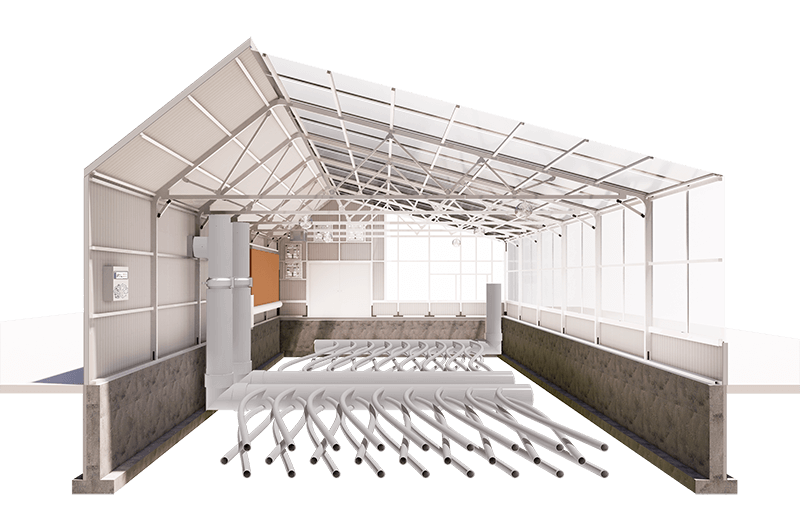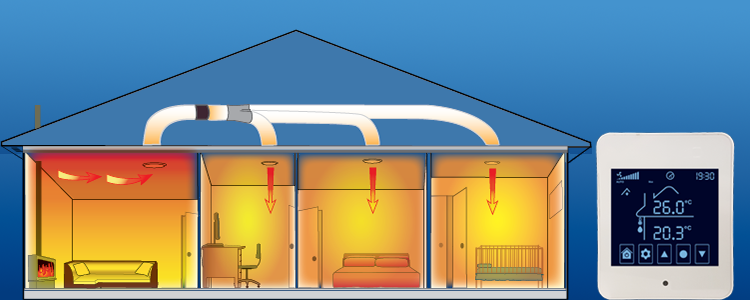How DVS Heat Transfer Systems Are Leading Sustainability Trends in Thermal Engineering
Wiki Article
A Comprehensive Overview to Choosing the Right Heat Transfer Systems for Your Needs
Selecting the appropriate Heat transfer system is crucial for operational effectiveness. Numerous systems satisfy various demands, affected by aspects such as temperature level variety and fluid kind. Comprehending the principles behind Heat transfer, such as radiation, transmission, and convection, is crucial. In addition, examining power sources and upkeep practices can impact long-lasting performance. A closer examination of these considerations discloses just how to tailor a system to specific demands. What should one prioritize in this complicated decision-making process?Recognizing Heat Transfer: Key Concepts and Concepts
Heat transfer may appear like an uncomplicated concept, it incorporates an array of principles that are essential for reliable system style - DVS Heat Transfer Systems. Understanding these concepts is vital for engineers and designers who intend to optimize thermal efficiency in numerous applications. Transmission, as an example, entails the transfer of Heat through strong products, while convection describes the movement of Heat within liquids. Radiation, an additional key principle, describes just how Heat can be transferred via electro-magnetic waves. Each of these devices plays a crucial function in determining how energy relocates within a system. By extensively grasping these principles, professionals can make enlightened decisions, ensuring that Heat transfer systems run effectively and satisfy the certain needs of their applications
Sorts Of Heat Transfer Equipments: A Review
Recognizing the concepts of Heat transfer lays the foundation for discovering the different types of Heat transfer systems offered. Heat transfer systems can be categorized primarily right into three kinds: convection, transmission, and radiation. Conduction involves Heat transfer via solid materials, counting on straight contact in between fragments. Convection, on the other hand, happens in liquids (gases and fluids) where the activity of the fluid itself facilitates Heat transfer. Radiation entails the transfer of Heat via electro-magnetic waves and does not require a medium, permitting it to occur in a vacuum. Each kind of system has distinctive characteristics and applications, making it essential for individuals and organizations to thoroughly evaluate their particular requirements when selecting one of the most appropriate Heat transfer service.Applications of Heat Transfer Equipments in Numerous Industries
Heat transfer systems play a crucial duty throughout various industries, affecting performance and product quality. In commercial production processes, they facilitate precise temperature level control, while in food and beverage handling, they ensure safety and security and preservation. In addition, HVAC and climate control systems rely greatly on efficient Heat transfer to preserve comfy atmospheres.Industrial Production Processes

Many commercial manufacturing processes rely heavily on effective Heat transfer systems to make the most of productivity and enhance item top quality. In markets such as metalworking, Heat exchangers play a vital duty in preserving optimal temperatures throughout welding, spreading, and forging. These systems guarantee consistent Heat circulation, which is crucial for achieving preferred product homes. Similarly, in the chemical manufacturing sector, Heat transfer systems facilitate specific temperature level control during reactions, affecting yield and safety and security. In textile production, reliable Heat administration is essential for dyeing and finishing processes, affecting color consistency and fabric top quality. By choosing suitable Heat transfer modern technologies, suppliers can enhance power effectiveness and lower operational prices, eventually resulting in a much more lasting and affordable manufacturing atmosphere.
Food and Drink Processing
Efficient Heat transfer systems are equally vital in the food and beverage handling industry, where keeping excellent temperature levels is critical for food safety and quality. These systems play a crucial function in procedures such as cooking, pasteurization, and sanitation, making sure that items are safe for intake and keep their nutritional value. Heat exchangers, for example, effectively move Heat between liquids, enhancing power usage while lessening temperature fluctuations. In addition, refrigeration systems are fundamental for extending and maintaining perishable items service life. The choice of Heat transfer modern technology straight affects functional performance and item honesty, making it necessary for food and beverage makers to pick the suitable systems customized to their certain processing demands. This cautious selection ultimately adds to customer complete satisfaction and food safety.
HVAC and Environment Control
While lots of sectors rely on Heat transfer systems for effectiveness, HVAC (Heating, Air Flow, and Air Conditioning) plays a crucial duty in maintaining interior environment control throughout numerous settings. These systems utilize Heat transfer principles to control air, temperature, and humidity quality, making sure comfort and security in household, commercial, and commercial atmospheres. Effectively designed a/c systems improve power efficiency, decrease operational expenses, and lessen ecological impact. In industrial structures, as an example, effective climate control adds to worker performance and customer contentment. In commercial applications, HVAC systems help maintain ideal problems for devices procedure and product conservation. Picking the ideal Heat transfer system is important for conference particular climate control demands and accomplishing general system performance.Reviewing Energy Sources for Heat Transfer Solutions
In assessing energy sources for Heat transfer systems, a contrast of renewable resource alternatives and fossil fuel considerations is important. Eco-friendly resources, such as solar and wind, offer sustainable alternatives that can reduce environmental influence. Alternatively, fossil gas continue to be prevalent as a result of their established framework and power density, motivating a careful analysis of both alternatives.Renewable Resource Options

Nonrenewable Fuel Source Considerations
Evaluating fossil fuel considerations is essential for the performance and sustainability of Heat transfer systems. Fossil fuels, such as gas, oil, and coal, are standard energy resources that offer considerable Heat result, making them prominent selections for industrial and residential applications. Nevertheless, their environmental impact, including greenhouse gas exhausts and source exhaustion, elevates worries. When choosing a warmth transfer system, it is important to analyze the accessibility, cost, and Our site regulatory factors connected with these gas. Furthermore, the efficiency of nonrenewable fuel source systems have to be taken into consideration, as greater efficiency can alleviate some ecological downsides. Inevitably, a balanced method considering performance and sustainability can lead decision-makers toward one of the most suitable Heat transfer remedy for their particular needs.useful site
Variables to Take Into Consideration When Choosing a Warmth Transfer System
Selecting a suitable Heat transfer system needs mindful consideration of different aspects that can considerably influence performance and efficiency. One essential factor is the operating temperature range, which dictates the products and style suitable for the application. Furthermore, the type of liquid used in the system-- whether gas or fluid-- influences Heat transfer efficiency and compatibility. The system's dimension and capacity have to line up with the certain demands of the procedure to prevent inadequacies. Energy resource schedule is likewise important, affecting operating expense and sustainability. Additionally, the installment setting, consisting of room restraints and access for upkeep, plays a considerable role in system selection. Ultimately, regulative compliance and safety and security requirements need to be taken into consideration to guarantee the system fulfills all legal requirements.Upkeep and Efficiency Optimization for Heat Transfer Equipments
Preserving Heat transfer systems is crucial for making certain optimal performance and longevity. Regular upkeep activities, such as cleaning up Heat exchangers and evaluating insulation, assistance stop efficiency losses as a result of fouling and thermal linking. Furthermore, keeping an eye on system parameters, consisting of stress and temperature, permits for early detection of abnormalities, lessening downtime and pricey repair services. Carrying out a preventive maintenance schedule can enhance performance and prolong the lifespan of components. In addition, updating to advanced control systems can boost functional effectiveness by readjusting to differing loads and conditions. By focusing on maintenance and performance optimization, drivers can accomplish minimized energy usage, reduced functional prices, and enhanced overall system integrity, inevitably leading to better source utilization and a more lasting procedure.Future Fads in Heat Transfer Technologies
As markets significantly focus on sustainability and power performance, future fads in Heat transfer technologies are set to undergo considerable makeovers. Developments such as sophisticated materials, including carbon nanotubes and nanofluids, assure improved thermal conductivity and effectiveness. Additionally, the assimilation of eco-friendly energy resources right into Heat transfer systems is acquiring momentum, promoting green solutions. Smart modern technologies, including IoT sensors, are expected to transform surveillance and control, allowing real-time information evaluation for enhanced performance. The development of modular and compact systems will certainly help with simpler installation and upkeep, catering to diverse applications. These innovations suggest a change towards more sustainable, efficient, and adaptable Heat transfer solutions, straightening with worldwide power goals and ecological standards.
Regularly Asked Concerns
What Are the Ecological Impacts of Heat Transfer Equipments?
The environmental effects of Heat transfer systems can consist of greenhouse gas emissions, power usage, and prospective thermal pollution. Additionally, incorrect disposal of inadequacies and materials can add to source depletion and ecosystem interruption.Just how Do I Calculate the Cost-Effectiveness of a Warmth Transfer System?
To calculate the cost-effectiveness of a heat transfer system, one need to analyze initial prices, functional expenditures, upkeep needs, and power effectiveness, comparing these factors versus the anticipated life-span and efficiency of the system.Can Heat Transfer Systems Be Utilized in Residential Settings?
Heat transfer systems can indeed be utilized in domestic setups. They supply efficient home heating and cooling services, making homes a lot more comfortable while potentially reducing energy prices. Their convenience allows for different applications in household environments.What Safety And Security Laws Apply to Heat Transfer Systems?
Safety and security policies for Heat transfer systems commonly include standards on setup, upkeep, and operation. Compliance with local visit this site right here structure codes, maker specs, and industry standards is necessary to guarantee secure and efficient system efficiency in numerous applications.Just How Do Various Products Affect Heat Transfer Efficiency?

Transmission, for instance, includes the transfer of Heat through solid products, while convection refers to the activity of Heat within liquids. Recognizing the principles of Heat transfer lays the foundation for checking out the different types of Heat transfer systems available. Heat exchangers, for circumstances, successfully move Heat in between fluids, maximizing power usage while minimizing temperature changes. In evaluating power sources for Heat transfer systems, a contrast of renewable power alternatives and fossil fuel considerations is vital. Metals, such as copper and aluminum, conduct Heat efficiently, whereas insulators like rubber and glass reduce down Heat flow.
Report this wiki page